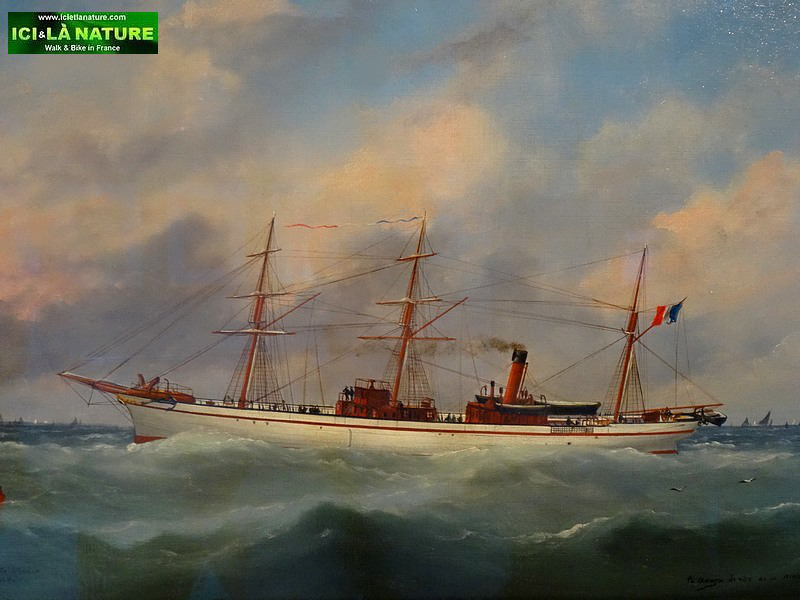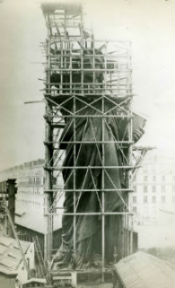
Latest:

Creating the Statue of Liberty
1865 – 1886

The Early Stages
In 1865, a French political intellectual and anti-slavery activist named Edouard de Laboulaye proposed that a statue representing liberty be built for the United States. This monument would honor the United States’ centennial of independence and the friendship with France. French sculptor Auguste Bartholdi supported Laboulaye’s idea and in 1870 began designing the statue of “Liberty Enlightening the World.”
While Bartholdi was designing the Statue, he also took a trip to the United States in 1871. During the trip, Bartholdi selected Bedloe’s Island as the site for the Statue. Although the island was small, it was visible to every ship entering New York Harbor, which Bartholdi viewed as the “gateway to America.”

In 1876, French artisans and craftsmen began constructing the Statue in France under Bartholdi’s direction. The arm holding the torch was completed in 1876 and shown at the Centennial Exposition in Philadelphia. The head and shoulders were completed in 1878 and displayed at the Paris Universal Exposition. The entire Statue was completed and assembled in Paris between 1881 and 1884. Also in 1884, construction on the pedestal began in the United States.



To the United States
After the Statue was presented to Levi P Morton, the U.S. minister to France, on July 4, 1884 in Paris, it was disassembled and shipped to the United States aboard the French Navy ship, Isère. The Statue arrived in New York Harbor on June 17, 1885, and was met with great fanfare. Unfortunately, the pedestal for the Statue was not yet complete and the entire structure was not reassembled on Bedloe’s Island until 1886.


Assembly
Once the pedestal was completed in 1886, the Statue was reassembled with surprising speed by a fearless construction crew – many of whom were new immigrants. The first piece of the Statue to be reconstructed was Alexandre-Gustave Eiffel’s iron framework. The rest of the Statue’s elements followed without the use of scaffolding – all construction materials were hoisted up by steam driven cranes and derricks. In order to sculpt the Statue’s skin Eiffel used the repoussé technique developed by Eugene Viollet-le-Duc. This technique was the process of molding light-weight copper sheets by hammering them onto the Statue’s hallowed wooden framework. The last section to be completed was the Statue of Liberty’s face which remained veiled until the Statue’s dedication. Although Fort Wood remained on Bedloe’s Island, it was not an obstacle in the design, construction, or reassembly of the Statue of Liberty. Instead, the star-shaped structure became a part of the Statue’s base – the pedestal sits within its walls.



Unveiled
On October 28, 1886, the statue of “Liberty Enlightening the World” was officially unveiled. The day’s wet and foggy weather did not stop some one million New Yorkers from turning out to cheer for The Statue of Liberty. Parades on land and sea honored the Statue while flags and music filled the air and the official dedication took place beneath the colossus “glistening with rain.” When it was time for Bartholdi to release the tricolor French flag that veiled Liberty’s face, a roar of guns, whistles, and applause sounded.
Link: https://www.nps.gov/stli/learn/historyculture/places_creating_statue.htm
*************************************
LOCMIQUELIC – L’ISERE
LOCMIQUELIC – L’Isère, un navire emblématique coulé devant Ste Catherine
L’ISERE
Mais quel est donc le lien unissant Locmiquélic et New York. Aucun sinon peut être cet emblèmatique navire coulé derrière le petit môle du port de Sainte Catherine, à savoir : la frégate “Isère”.

Histoire
Mis sur cale le 13 juillet 1863, la frégate « Isère » ne prendra contact avec son élément que le 22 avril 1866 lors de son lancement à l’arsenal de Lorient. Son admission au service actif aura lieu en juin 1866.
Combien sont les personnes ignorant sa présence sous la mer, en rade de Lorient ? Combien savent que son épave gît devant le port de Sainte Catherine à Locmiquélic ? Et combien ont connaissance que « l’Isère » est surtout connue pour avoir transporté la célèbre statue de la Liberté de Bartholdi jusqu’à New York ?
Les caractéristiques du navire
Construit sur les plans de la « Moselle »[1], transport mixte acheté en Angleterre le 23 mai 1859, « L’Isère » est un trois mâts barque de 67,20 m de long pour 9,43 m de large dont la mise sur cale, sur les bords du Scorff, a débuté le 13 juillet 1863. Gréé pour la navigation à la voile avec 682 m2 de voilure, ce gros transporteur de la marine profite également des technologies de pointe de l’époque comme une coque en métal, une machine à vapeur de 160 ch[2] ou la propulsion à hélice. Outre « L’Isère », et la « Moselle », la série, dite des 1200 tonneaux, comprendra treize navires dont la « Vienne », la « Dordogne », la « Durance », etc.… Trois de ces navires (Marne, Meuse et Yonne) seront rehaussés d’un pont lors d’un grand carénage en 1863.
Une quatorzième corvette transporteur, la « Caravane », construite 15 ans plus tard toujours sur les mêmes plans, achèvera définitivement cette belle série.
1866 – 1884 – CABOTAGE LE LONG DES COTES FRANCAISES
Pendant dix huit années, « L’Isère » va assurer de nombreuses missions de transport tant en Atlantique qu’en Méditerranée. De Lorient au Havre ou de Cherbourg à TOULON en passant par Rochefort, aucun grand port militaire ne sera oublié.
1884 – VOYAGE AU TONKIN
Le……..1884, la frégate quittera le port de Saint Nazaire pour le Tonkin (partie septentrionale du Viêtnam actuel) et ses principaux ports, Haïphong, Tourane et Saigon qu’elle sillonnera durant presqu’une année avant de revenir en France.

Carte de la Cochinchine
DE NEW YORK A LOCMIQUELIC
1885 – SA PERIODE DE GLOIRE
C’est en mai 1885 que le navire arrivera au port de Rouen afin d’y embarquer la célèbre statue de la Liberté. Il chargera à son bord 210 caisses, 80 tonnes de cuivre et 20 tonnes d’acier qu’il livrera à New York le 19 juin 1885 après une traversé difficile ponctuée de plusieurs tempêtes en Atlantique nord.
C’est au capitaine de vaisseau Gabriel LESPINASSE de SAULNE, né à Toulouse le 11 juillet 1846, que le gouvernement Français confiera cette mission honorifique de porter au peuple américain la statue. Une reproduction miniature de la statue lui sera offerte lors de l’inauguration.

La statue de la Liberté de Bartholdi
SON ARRIVEE DEVANT LOCMIQUELIC
De retour à Brest à l’automne 1885, la frégate « Isère » y subira une grande refonte en 1904, durant laquelle elle recevra une nouvelle machine avant sa remise en service. En 1908, le navire marche mal et vu l’état de sa coque, sa mise à la retraite est décidée. C’est à l’arsenal de Rochefort que son désarmement aura lieu en décembre 1909.
Condamnée en mars 1911, sa coque, remorquée par le « RENNE », quittera Rochefort en avril 1924 en direction de Lorient où elle servira de ponton. Durant son transfert, le convoi sera pris dans une tempête et devra relâcher à Quiberon le 27 avril 1924.
A son arrivée à l’arsenal de Lorient le 29 avril 1924, elle sera utilisée comme ponton sur la rive droite du Scorff jusqu’en juin 1940 date à partir de laquelle elle servira à l’accostage des U-Boat Allemands. Elle verra également accoster les canonnières « Audacieuse » et « Surveillante ». En mars 1941, le ponton « Isère » quittera définitivement les rives du Scorff pour celles du Ter[3] et sa sombre base de sous-marins où elle sera touchée par les bombardements du 13 février 1943.
Sabordée par les Allemands en 1945, puis dynamitée en 1990 afin de permettre l’agrandissement et l’accès du port de plaisance de Locmiquélic sa coque gît toujours par …. mètres de fond dans le petit chenal face au môle de sainte Catherine.
Dans un extrait du journal « Le Télégramme » en date du 3 mars 2009, on y découvre que : « grâce au travail de passionnés, l’Isère continue de vivre en 3D sur les écrans de l’association ………… musée sous-marin MSMPL.. » . Il est même précisé que « On y découvrirait très clairement qu’une forêt de laminaires et de spirographes (vers marins) ont colonisé l’épave ».
(Extrait de l’exposition proposée par l’association en 2009 à l’occasion des 90 ans de la commune)
2015 – LOCMIQUELIC FETE L’ISERE
Les 4 et 5 juillet Locmiquélic fête l’Isère. Une réplique miniature de la statue de la Liberté ainsi que des panneaux explicatifs sont mis en place sur le port de Sainte Catherine, rappelant aux promeneurs que l’ épave gît en bordure des pontons, lieu où le navire a fini sa carrière en 1945.
Revivez en images ces deux journées dans l’onglet
http://la-memoire-minahouets.reseaudesassociations.fr/fr/information/41213/edition-2015-isere-1
———————————————————————————————————————————–
[1] La Moselle est l’un des premiers transports de matériel construit en fer qui ne soit pas une gabare à voile. Elle servira de modèle pour la construction de la « Vienne » et de « l’Isère ».
[2] Cette machine sera remplacée par une de 800 chn en 1904.
[3] Autre rivière se jetant dans la rade de Lorient
Liens : http://la-memoire-minahouets.reseaudesassociations.fr/fr/information/40797/l-isere
 Statue of Liberty NM
Statue of Liberty NM